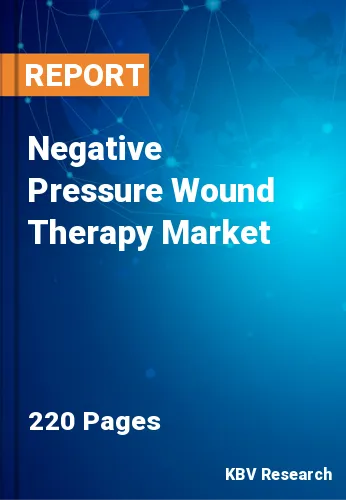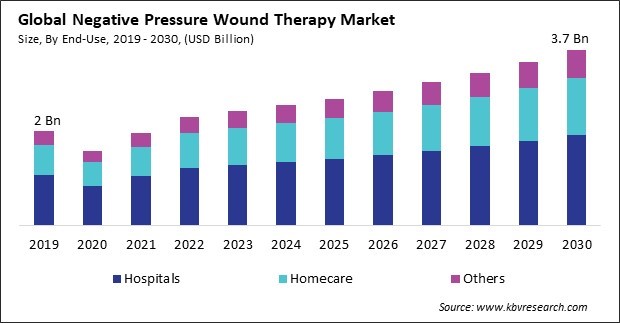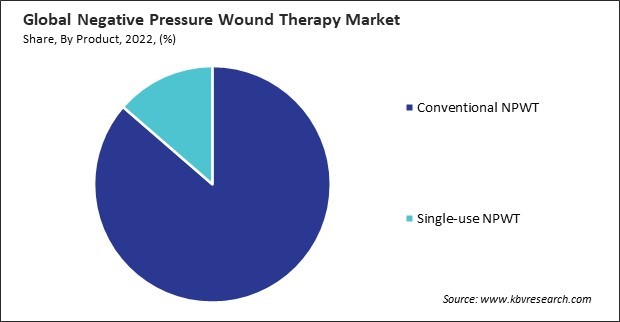
The Global Negative Pressure Wound Therapy Market size is expected to reach $3.7 billion by 2030, rising at a market growth of 6.3% CAGR during the forecast period.
Venous leg ulcers are often chronic and challenging to manage due to underlying venous insufficiency. NPWT provides a comprehensive approach to wound care by addressing the specific characteristics of venous leg ulcers, such as high exudate levels and delayed healing. Consequently, the venous leg ulcers segment would acquire nearly 13% of the total market share by 2030. NPWT facilitates granulation tissue formation in the wound bed, a critical aspect of healing venous leg ulcers. By creating a controlled environment, NPWT accelerates healthy tissue formation and contributes to overall wound closure.

Outpatient care and home healthcare enhance accessibility and convenience for patients. NPWT devices that can be utilized in these settings allow patients to receive advanced wound care without prolonged hospital stays, contributing to a more patient-friendly experience. The shift towards outpatient care and home healthcare aligns with a patient-centric approach to healthcare. NPWT, with its focus on promoting patient comfort and improving outcomes, complements this approach and contributes to patient satisfaction. Thus, the market is expanding significantly due to the rapid shift towards outpatient care and home healthcare. Additionally, the escalating rates of diabetes globally contribute to the rising incidence of diabetic foot ulcers. NPWT has proven to be particularly effective in managing diabetic wounds, driving its adoption as a standard of care in many healthcare settings. Infections and complications that progress to more serious health problems are common in diabetic wounds. NPWT helps reduce the risk of complications by creating a sealed environment that minimizes the potential for infections, promoting a faster and more controlled healing process. Therefore, increasing prevalence of diabetes has been a pivotal factor in driving the growth of the market.
Moreover, Disruptions in global supply chains resulted from the pandemic, which impacted the manufacturing and dissemination of medical devices, including NPWT systems and consumables. Manufacturers faced raw material shortages, transportation restrictions, and workforce disruptions. The prolonged nature of the pandemic, with lockdowns and restrictions affecting daily life, contributed to an increase in chronic wounds and pressure injuries. Patients, especially those at higher risk, experienced delays in seeking healthcare, leading to more complex wounds requiring advanced treatments like NPWT. Thus, the COVID-19 pandemic had a moderate effect on the market.
However, the initial cost of NPWT devices can be relatively high. This cost factor may limit the adoption of NPWT, particularly in regions or healthcare systems with budget constraints. The affordability of these devices remains a significant challenge for widespread implementation. The high cost of NPWT devices can influence reimbursement policies and coverage decisions. Payers may hesitate to provide adequate reimbursement for NPWT procedures, limiting the financial support available for healthcare providers and patients. Thus, high cost of NPWT devices can slow down the growth of the market.
 Drivers
Drivers  Restraints
Restraints  Opportunities
Opportunities  Challenges
Challenges On the basis of end-use, the market is divided into hospitals, homecare, and others. The homecare segment garnered a significant revenue share in the market in 2022. Homecare is a patient-centered healthcare approach that provides treatment in the convenience and comfort of an individual's home. NPWT's application at homecare aligns with this trend, providing patients with a more personalized and less disruptive experience compared to inpatient care. NPWT in homecare settings enables the extended continuity of care. Patients recovering from surgery, managing chronic wounds, or undergoing post-acute care can continue their NPWT treatment seamlessly at home, contributing to better overall outcomes.
By product, the market is categorized into conventional NPWT and single-use NPWT. The single-use NPWT segment covered a considerable revenue share in the market in 2022. Single-use NPWT devices are often designed to be compact and portable, offering flexibility in terms of patient mobility. This is particularly advantageous in outpatient settings and home healthcare, where patients can continue their treatment conveniently. Single-use NPWT devices often use advanced dressing materials for optimal performance and comfort. These materials are selected to promote effective negative pressure, manage exudate, and create an environment conducive to wound healing.

Based on type, the market is classified into diabetic foot ulcers, venous leg ulcers, pressure ulcers, burn wounds, and others. The diabetic foot ulcers segment acquired a substantial revenue share in the market in 2022. Diabetic foot ulcers are often chronic and complex wounds that require specialized care. NPWT provides a comprehensive approach to wound management by promoting granulation tissue formation, reducing edema, and addressing the specific challenges associated with DFUs. DFUs can lead to severe complications, and in some cases, amputation may be necessary. The use of NPWT in treating diabetic foot ulcers has been associated with reduced amputation rates. This positive outcome benefits patients and contributes to the overall demand for NPWT.
Free Valuable Insights: Global Negative Pressure Wound Therapy Market size to reach USD 3.7 Billion by 2030
Region-wise, the market is analysed across North America, Europe, Asia Pacific, and LAMEA. In 2022, the North America region led the market by generating the highest revenue share. The prevalence of chronic wounds, such as diabetic foot ulcers, pressure ulcers, and venous leg ulcers, is on the rise in North America. North America has a highly advanced healthcare infrastructure, including advanced medical facilities and a focus on adopting cutting-edge medical technologies. The aging population in North America, particularly in the United States, has led to a higher prevalence of chronic conditions such as diabetes.
| Report Attribute | Details |
|---|---|
| Market size value in 2022 | USD 2.3 Billion |
| Market size forecast in 2030 | USD 3.7 Billion |
| Base Year | 2022 |
| Historical Period | 2019 to 2021 |
| Forecast Period | 2023 to 2030 |
| Revenue Growth Rate | CAGR of 6.3% from 2023 to 2030 |
| Number of Pages | 220 |
| Number of Tables | 359 |
| Report coverage | Market Trends, Revenue Estimation and Forecast, Segmentation Analysis, Regional and Country Breakdown, Porter’s 5 Forces Analysis, Company Profiling, Companies Strategic Developments, SWOT Analysis, Winning Imperatives |
| Segments covered | Product, Type, End-Use, Region |
| Country scope |
|
| Companies Included | 3M Company, Talley Group Ltd. (Direct Healthcare Group), Smith & Nephew PLC, Molnlycke Health Care AB, DeRoyal Industries, Inc., ConvaTec Group PLC, Cardinal Health, Inc., HARTMANN Group (Paul Hartmann AG) and Cork Medical, LLC |
By End-Use
By Product
By Type
By Geography
This Market size is expected to reach $3.7 billion by 2030.
Rapid shift towards outpatient care and home healthcare are driving the Market in coming years, however, High cost of NPWT devices restraints the growth of the Market.
3M Company, Talley Group Ltd. (Direct Healthcare Group), Smith & Nephew PLC, Molnlycke Health Care AB, DeRoyal Industries, Inc., ConvaTec Group PLC, Cardinal Health, Inc., HARTMANN Group (Paul Hartmann AG) and Cork Medical, LLC
The expected CAGR of this Market is 6.3% from 2023 to 2030.
The North America region dominated the Market, By Region in 2022, and would continue to be a dominant market till 2030; thereby, achieving a market value of $1.3 billion by 2030.
Our team of dedicated experts can provide you with attractive expansion opportunities for your business.
